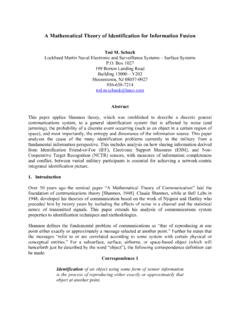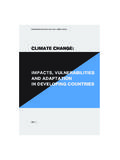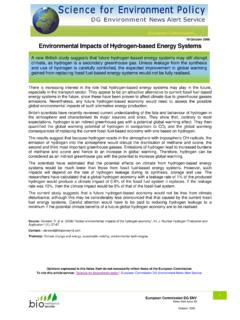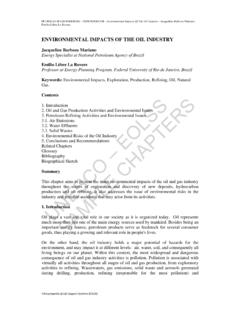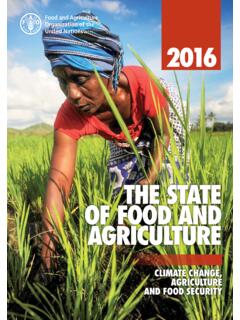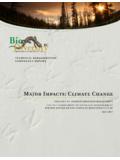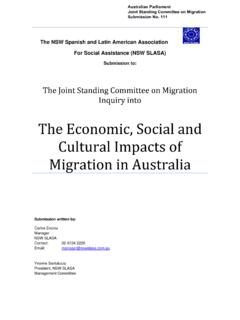Transcription of The Information Age: An Anthology on its Impact and ...
1 The Information Age: An Anthology on Its Impact and Consequences Edited by David S. Alberts and Daniel S. Papp CCRP Publication Series 1997 Table of Contents Preface: Technology and Change in Human Affairs .. ii Part One The Information and Communication 1 2 Chapter 1: Welcome to the Revolution*.. 5 Chapter 2: Historical Impacts of Information Technologies: An 13 Chapter 3: The Technologies of the Information Revolution .. 36 Chapter 4: What Information Society?* .. 51 Chapter 5: Alone Together: Will Being Wired Set Us Free? * .. 72 Chapter 6: Reality Check * .. 78 Part Two: Business, Commerce, and 84 85 Chapter 7: The Coming Electronic Commerce (R)evolution * .. 88 Chapter 8: Electronic Commerce: Implications of the Internet for Business Practice and Strategy *.. 97 Chapter 9: Banking and Cyberspace: The New Promised Land *.
2 107 Chapter 10: Silicon Summit: Will Technology Affect the News? Executive Summary * .. 113 Chapter 11: Medical Informatics * .. 122 Chapter 12: School Reform in the Information Age *.. 132 Chapter 13: Universities in the Digital Age *.. 145 Part Three: Government and the Military .. 162 163 Chapter 14: Telecommunications and Democracy * .. 167 Chapter 15: Freedom and Censorship in the Emerging Electronic Environment *.. 181 Chapter 16: Cyberpower * .. 191 Chapter 17: Congress, Information Technology, and the Use of Force .. 197 Chapter 18: The Media's Impact on International Affairs, Then and Now * .. 206 Chapter 19: Warfare in the Information Age * .. 217 Part Four: International 228 229 Chapter 20: Telecommunications and the Changing Geographics of Knowledge Transmission in the Late 20th Century * .. 233 Chapter 21: Technology, Change, and the Emerging International Order *.
3 248 Chapter 22: Connecting Developing Countries to the Information Technology Revolution *.. 268 Chapter 23: Little Engines That Could: Computing in Small Energetic Countries *278 Chapter 24: The Impacts of the Information Age on International Actors and the International System .. 285 About the 297 About the Editors .. 300 i Acknowledgments This Anthology is the product of the ideas and work of many individuals. Ervin J. Rokke first suggested the need for this Anthology and organized a series of meetings to discuss potential topics for inclusion in such a volume. David Johnson helped sort and make sense of the many suggestions received. Alissa Tuyahov and W. Thomas Kemp, III spared no effort in searching out the "pearls" from various fields for this volume. Among the many individuals who contributed helpful suggestions were Jerry Smith, Tom Czerwinski, Gerry Gingrich, Fred Giessler, Dan Kuehl, Jamie Gough, Paul Davis, and Dick Hayes.
4 A debt of gratitude is also due to George Maerz and Lydia Candland, who edited and prepared the final manuscript, and Karina Brazco, who created the cover graphic. ii Preface: Technology and Change in Human Affairs by Daniel S. Papp and David Alberts With the fall of communism in Eastern Europe and the dissolution of the Soviet Union, the Cold War ended, and the half-century-old bipolar international system disappeared. These were earthshaking events that rightly received and are receiving extensive study and analysis. They occurred for a host of reasons, many of which were related to the internal political, economic, social, and cultural dynamics of communist states. Several of the more important reasons were the resentment of citizens of communist states toward the institutions and individuals that governed them; a resurgence of nationalism within multinational states; the inability of communist states to transition successfully from centralized political, economic, and administrative structures to more decentralized structures; inadequate economic growth rates and declining standards of living; the inability of communist states to diffuse technical advances throughout productive sectors of society; and over-emphasis on defense Even as communist states disintegrated from within, another revolution was accelerating.
5 This quieter revolution, still in its infancy, is a scientific and technological one. It s Impact has already been felt, and it promises to change human affairs and the international system as extensively as, perhaps even more extensively than, the collapse of the bipolar international system. The revolution in scientific and technological affairs has many dimensions and has led to a debate about whether scientific-technical advances are changing only the conduct of human affairs and the relationships between present-day international actors, or also the very form and structure of humankind s institutions and international actors Throughout history, advances in Information and communication technologies, energy and transportation technologies, biotechnology and life sciences, agriculture and industry, weapons technologies, and other scientific-technical fields have played important roles in driving changes in the ways that men and women conduct their affairs.
6 This has been true in virtually every realm of human endeavor including business and banking, industry and manufacturing, government policy and military affairs, international relations, education and research, social and cultural relations, political affairs, entertainment and news, and Given the magnitude of change that the revolution in science and technology has potential to induce, it is vitally important that we understand how this revolution, has changed, is changing and will continue to change our world. Developing such an understanding is a difficult task. It requires an appreciation and comprehension of the past and present impacts of science and technology on various aspects of the human condition, human endeavors, group and organizational dynamics, and on different types of international actors.
7 It also requires an ability to extrapolate from this foundation with a willingness to engage in informed speculation about the impacts that future advances may have and to develop scenarios of how changes in human activities and international actors may interact to form a new international system. iii This book undertakes this task for one major category of scientific and technical advances, Information and communication technologies. It is based on historical fact, reasoned speculation about future trends in Information and communication technologies, and informed analysis about the impacts that those trends might have on human affairs and the international system as we move into the Information Age. This is the first volume in a two volume set that will lay the foundation for understanding the ways that the Information Age is changing our environment and the institutions upon which we depend for our liberty, health, and happiness.
8 In this first volume, we will examine some of the broader issues of the Information Age: what the Information Age is; how it affects commerce, business, and service; what it means for the government and the military; and how it affects international actors and the international system. Not everyone will agree with the viewpoints presented here, but that is as it should be; the purpose of this volume and its successor is more to generate thoughtful debate and discussion than to provide definitive answers. In the second volume, we will examine in more detailed terms the meaning of the Information Age for the military. It must be stressed, however, that the two volumes go hand-in-hand; the military is an imbedded system, imbedded in the environment in which it must operate.
9 Challenges of the Information Age Complexity and change are the two defining characteristics of the Information Age. Our successes as individuals, families, organizations, communities, and societies will depend more than ever upon our abilities to adapt, in near real time, to deal with increasingly complex and dynamic situations which will be characteristic of the Information Age. Each of us, individually and institutionally, has developed mechanisms to either shield us from or deal with complexity and change. Sometimes these mechanisms work too well. That is, they prevent us from sensing how much our worlds are changing, thus robbing us of an opportunity to understand our environment and appropriately modify old responses or develop new responses. The results are often catastrophic; we break rather than bend.
10 History is replete with examples of changed environments that were recognized too late for an institution to successfully adapt. Similarly, history also has many examples of changed environments that were recognized, but by institutions or societies that were themselves unwilling or unable to adapt to new conditions. The Information Age is and will continue to present us with these kinds of challenges at an alarming rate. The increasing complexity of our environment and the actions necessary to maintain or improve our equilibrium will only serve to make these challenges even more difficult. Successfully responding to these challenges will require three things. First, we will need to recognize that something has changed. Second, we will need to understand the implications of this change.







